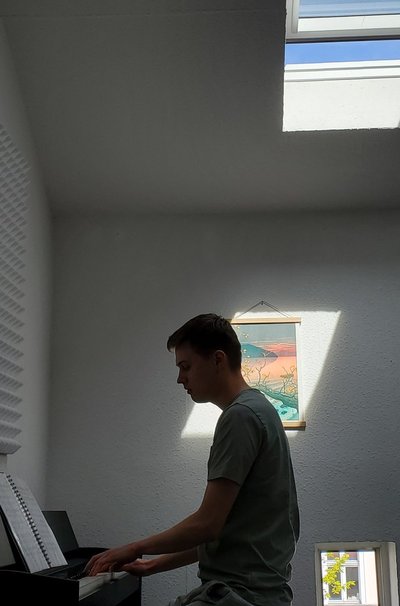Improvising piano music is creating the plot line of a story in real time. I improvise regularly on the piano, mostly by stealing like an artist and using the chord progressions of a song I like. I build my own flair and style into it, changing the chorus, theme, tempo, and general feel of the song. Sometimes I start out by playing the original song itself and merge into an improvisation, other times I just go for it.


I foreshadow when I improvise. Since I need to stick to one key (generally speaking), the notes I use will be repeated soon, so I can play around with this and use it to my advantage. I start by playing chords and then turn them into arpeggios when I change the rhythm. I use the slower tempo of the beginning to foreshadow the coming of the arpeggios; without setting this foundation first, the arpeggios would just sound like random notes.
I mix in different characters when I improvise. How many people are singing my song? I can use the lower octaves to keep the bass running while picking one, two, or more octaves to repeat or enhance the same rhythm. To me this makes it sound like there are multiple voices of different people, potentially of different ages, involved in the song. If I really want to emphasize a rhythm, I can play it low, close to the bass line or on top of it, to sound more like it comes from authority. Towards the end, I can move down the octaves from high to low to get everyone involved and wrap it up. I only have two hands, but I can play one note in two octaves to make it sound like two “characters” are working together at the song.
If I fill in more notes to make larger 3- or 4-key chords, the sound becomes a wall of audio in addition to my main characters. They are now joined by the unseen orchestra that amplifies their emotion. I may hold out to do this until the song builds up, and the original intro from the main character has merged into a “response” from a second character in my plot.
When I improvise, I try to imagine a scenario or some scene or collection of themes that drive the feeling and sense about the music. I need to drive a plot line that I cannot retroactively edit. I vary the tempo and intensity to mimic the variation in the world of fast and slow, deep and shallow, conversations with self and conversations with others or a whole group.
The characters of my plot do not have to work together in every aspect. They must retain the same key so that the sound is bearable, but I can work in an antagonist to break apart some of the flow and add a dynamic to my improvisation that mimics the push and pull of an argument. Normally I try to do this very simply by repeating the same chord in the midst of a bunch of other things happening, so it sounds like someone is trying to interject.
Quite honestly, the toughest part is switching the tone and moving onto the next part of the song. Time only moves forwards, so if I want to break down the fast part of the song into a slower rhythm, I have to foreshadow it in real-time so that it doesn’t seem almost like a non-sequitur. Downshifting music is difficult when there’s so much momentum behind the scene. I can create a smoking gun that halts the progression of the rhythm. I can slowly defuse tension by decreasing the BPM until the rhythm is forced to stumble (gracefully) and turn slower. I can take out the bass line and have a single singer complete a small bit, then merge into the next part.
Shifting upwards is a little easier. I mentioned earlier that I switched the chords into arpeggios - this is an excellent tactic to increase the BPM and change the rhythm, since arpeggios naturally come across as faster than just playing the notes all together at the same time.
I have to consider: where are we going with the plot? A great adventure has ups and downs, but I don’t want to create too many builds and busts as it will become uninteresting and over-engineered. The 3-act structure of a play also applies for songs. If I really want to do more than two builds, I might as well play another song and switch the key.
Quality over quantity is a judgment call depending on where you’re playing. I spent an hour in a cake shop north of Berlin since I saw it had a old piano pictured on its Google Maps review. I played the piano, but mostly just tinkered with it, instead of trying to explore some deep and grand scene. They offered me a free piece of carrot cake. Tinkering counts as improvisation, but it lacks some depth. Tinkering is great for practice, and to try out different rhythms, chords, and keys.
Finally, the theme of the improvisation may assume that some scene itself is a performance. The emotions are exaggerated, the tone purposefully starts shy and rises to something huge. It is up to the artist to not over-exaggerate their piece. Some things can be ported from the brain into musical form without considering that it’s being performed, but most seem to assume that the world around is itself on a stage. The wind in the grass whispering, the chaos and lull of train stations, the rising and setting sun, the oscillation of the world itself is both the mirror and looking glass of a very persistent and slightly anxious individual, the artist.
Daniel